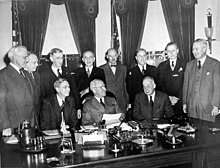
The Manhattan Project was a program of research and development undertaken during World War II to produce the first nuclear weapons. It was led by the United States in collaboration with the United Kingdom and with support from Canada. From 1942 to 1946, the project was under the direction of Major General Leslie Groves of the U.S. Army Corps of Engineers. Nuclear physicist J. Robert Oppenheimer was the director of the Los Alamos Laboratory that designed the bombs. The Army component was designated the Manhattan District, as its first headquarters were in Manhattan; the name gradually superseded the official codename, Development of Substitute Materials, for the entire project. The project absorbed its earlier British counterpart, Tube Alloys. The Manhattan Project grew rapidly and employed nearly 130,000 people at its peak and cost nearly US$2 billion. Over 90 percent of the cost was for building factories and to produce fissile material, with less than 10 percent for development and production of the weapons. Research and production took place at more than 30 sites across the United States, the United Kingdom, and Canada.

Vannevar Bush was an American engineer, inventor and science administrator, who during World War II headed the U.S. Office of Scientific Research and Development (OSRD), through which almost all wartime military R&D was carried out, including important developments in radar and the initiation and early administration of the Manhattan Project. He emphasized the importance of scientific research to national security and economic well-being, and was chiefly responsible for the movement that led to the creation of the National Science Foundation.

William Sterling Parsons was an American naval officer who worked as an ordnance expert on the Manhattan Project during World War II. He is best known for being the weaponeer on the Enola Gay, the aircraft which dropped an atomic bomb on Hiroshima, Japan, in 1945. To avoid the possibility of a nuclear explosion if the aircraft crashed and burned on takeoff, he decided to arm the bomb in flight. While the aircraft was en route to Hiroshima, Parsons climbed into the cramped and dark bomb bay, and inserted the powder charge and detonator. He was awarded the Silver Star for his part in the mission.

Tube Alloys was the research and development programme authorised by the United Kingdom, with participation from Canada, to develop nuclear weapons during the Second World War. Starting before the Manhattan Project in the United States, the British efforts were kept classified, and as such had to be referred to by code even within the highest circles of government.
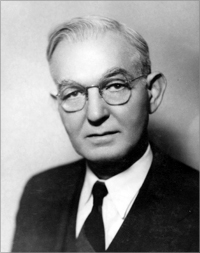
George Braxton Pegram was an American physicist who played a key role in the technical administration of the Manhattan Project. He graduated from Trinity College in 1895, and taught high school before becoming a teaching assistant in physics at Columbia University in 1900. He was to spend the rest of his working life at Columbia, taking his doctorate there in 1903 and becoming a full professor in 1918. His administrative career began as early as 1913 when he became the department's executive officer. By 1918, he was Dean of the Faculty of Applied Sciences but he resigned in 1930 to relaunch his research activities, performing many meticulous measurements on the properties of neutrons with John R. Dunning. He was also chairman of Columbia's physics department from 1913 to 1945.

George Bogdanovich Kistiakowsky was a Ukrainian-American physical chemistry professor at Harvard who participated in the Manhattan Project and later served as President Dwight D. Eisenhower's Science Advisor.

The Quebec Agreement was a secret agreement between the United Kingdom and the United States outlining the terms for the coordinated development of the science and engineering related to nuclear energy and specifically nuclear weapons. It was signed by Winston Churchill and Franklin D. Roosevelt on 19 August 1943, during World War II, at the First Quebec Conference in Quebec City, Quebec, Canada.
The Office of Scientific Research and Development (OSRD) was an agency of the United States federal government created to coordinate scientific research for military purposes during World War II. Arrangements were made for its creation during May 1941, and it was created formally by Executive Order 8807 on June 28, 1941. It superseded the work of the National Defense Research Committee (NDRC), was given almost unlimited access to funding and resources, and was directed by Vannevar Bush, who reported only to President Franklin Delano Roosevelt.

The Metallurgical Laboratory was a scientific laboratory at the University of Chicago that was established in February 1942 to study and use the newly discovered chemical element plutonium. It researched plutonium's chemistry and metallurgy, designed the world's first nuclear reactors to produce it, and developed chemical processes to separate it from other elements. In August 1942 the lab's chemical section was the first to chemically separate a weighable sample of plutonium, and on 2 December 1942, the Met Lab produced the first controlled nuclear chain reaction, in the reactor Chicago Pile-1, which was constructed under the stands of the university's old football stadium, Stagg Field.
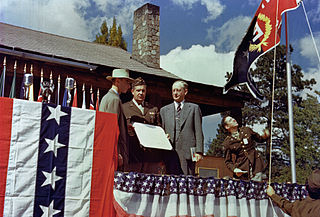
The Manhattan Project was a research and development project that produced the first atomic bombs during World War II. It was led by the United States with the support of the United Kingdom and Canada. From 1942 to 1946, the project was under the direction of Major General Leslie Groves of the US Army Corps of Engineers. The Army component of the project was designated the Manhattan District; "Manhattan" gradually became the codename for the entire project. Along the way, the project absorbed its earlier British counterpart, Tube Alloys. The Manhattan Project began modestly in 1939, but grew to employ more than 130,000 people and cost nearly US$2 billion. Over 90% of the cost was for building factories and producing the fissionable materials, with less than 10% for development and production of the weapons.
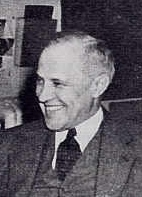
Karl Taylor Compton was a prominent American physicist and president of the Massachusetts Institute of Technology (MIT) from 1930 to 1948.
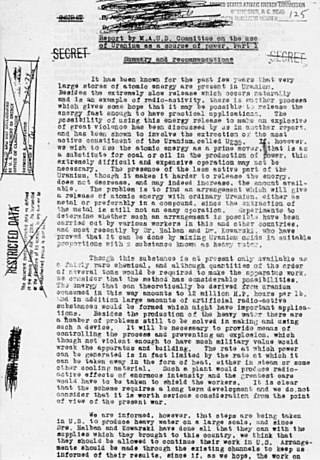
The MAUD Committee was a British scientific working group formed during the Second World War. It was established to perform the research required to determine if an atomic bomb was feasible. The name MAUD came from a strange line in a telegram from Danish physicist Niels Bohr referring to his housekeeper, Maud Ray.
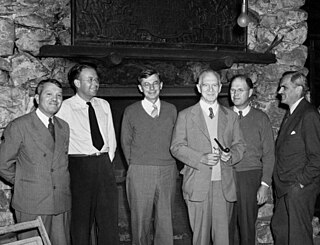
The S-1 Executive Committee laid the groundwork for the Manhattan Project by initiating and coordinating the early research efforts in the United States, and liaising with the Tube Alloys Project in Britain.
The Applied Mathematics Panel (AMP) was created at the end of 1942 as a division of the National Defense Research Committee (NDRC) within the Office of Scientific Research and Development (OSRD) in order to solve mathematical problems related to the military effort in World War II, particularly those of the other NDRC divisions.
The Science Advisor to the President is an individual charged with providing advisory opinions and analysis on science and technology matters to the President of the United States. The first Science Advisor, Vannevar Bush, chairman of the Office of Scientific Research and Development, served Presidents Franklin Delano Roosevelt and Harry S. Truman from 1941 to 1951. President Truman created the President's Science Advisory Committee in 1951, establishing the chairman of this committee as the President's Science Advisor. This committee continued under Presidents Dwight D. Eisenhower, John F. Kennedy, Lyndon B. Johnson, and Richard M. Nixon until 1973. Nixon terminated the committee rather than appointing a replacement for his advisor who had resigned. The US Congress established the Office of Science and Technology Policy in 1976, re-establishing Presidential Science Advisors to the present day.
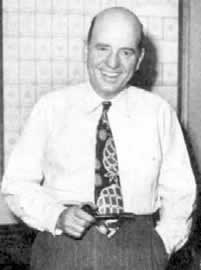
Charles Allen Thomas was a noted American chemist and businessman, and an important figure in the Manhattan Project. He held over 100 patents.

The Montreal Laboratory in Montreal, Quebec, Canada, was established by the National Research Council of Canada during World War II to undertake nuclear research in collaboration with the United Kingdom, and to absorb some of the scientists and work of the Tube Alloys nuclear project in Britain. It became part of the Manhattan Project, and designed and built some of the world's first nuclear reactors.

The Radiation Laboratory, commonly called the Rad Lab, was a microwave and radar research laboratory located at the Massachusetts Institute of Technology (MIT) in Cambridge, Massachusetts. It was first created in October 1940 and operated until 31 December 1945 when its functions were dispersed to industry, other departments within MIT, and in 1951, the newly formed MIT Lincoln Laboratory.

Britain initiated the first research project to design an atomic bomb in 1941 and helped the United States to recognise how important this type of research was and get the Manhattan Project started in 1942 as well as contributing to carrying this through to successful completion in August 1945 by supplying crucial expertise to the project.
